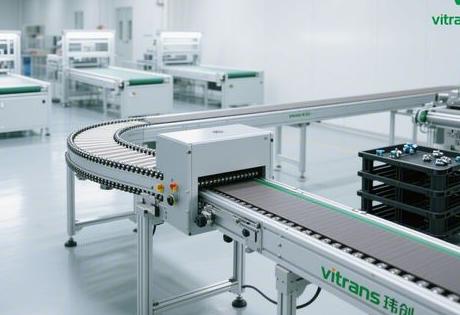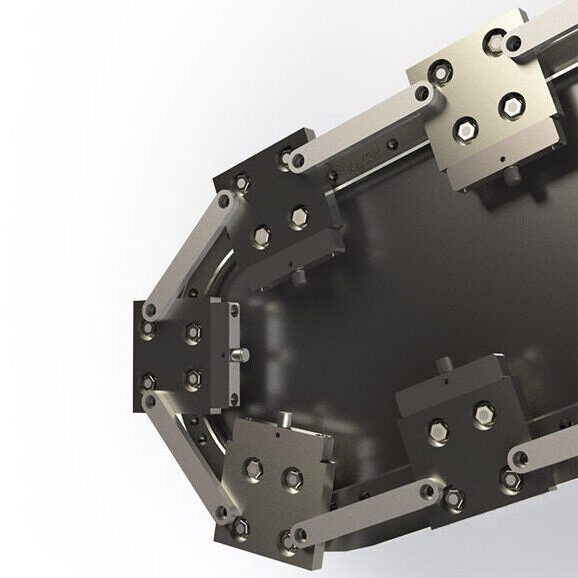I. Technical principles and structural innovations: engineering philosophy for precision transmission
The core value of the display multiplier chain production line is thatReconfiguring the panel manufacturing process through the synergy of physical speed-up and intelligent control. The basic principle is to use the diameter difference (D>d) between the roller (diameter D) and the roller (diameter d), so that the work plate to obtain the chain speed 1.5-3 times the conveying efficiency. However, three major technical bottlenecks need to be broken through in the display manufacturing scenario:

- Micron-level vibration-proof design: The air spring vibration isolation system is adopted to control the amplitude within ±0.3μm to avoid display defects caused by liquid crystal molecule deviation;
- Dynamic elimination of static electricity: Conductive rollers (surface resistance 10⁶-10⁹Ω) in combination with ionic air rods reduce the ESD damage rate by 90%;
- Cleanroom Adaptive StructuresFully sealed chain cabin with integrated negative pressure dust removal system reduces dust leakage rate by 98.7% and meets Class 1000 cleanliness standards.
personal viewpoint: The essence of the display production line is the "precision concert of the optical path and circuit". A panel factory measured data show that the use of multiplier chainYield Improvement 12%--The heart of the process is not simply speed, but the "molecular stability" of each glass substrate in transmission by eliminating vibration and electrostatic interference.
II. Production model and system integration: the nerve centre of flexible manufacturing
1. Modular architectural design
- Three-step adjustable work stationThe pitch of the workpiece board supports 0.8m-1.2m dynamic switching, which is suitable for multi-size production from mobile phone screen to 85" TV;
- Electricity-carrying operation systemConductive wheels are built into the wire, and conductive rows are mounted on the work plate to achieve the simultaneous completion of power-on aging and signal detection;
- stereoscopic circulation network: By jacking up the transplanter + right-angle steering machine, it forms a double-layer return closure, and the space utilisation is increased by 40%.
2. Intelligent control systems
plaintextmake a copy of| Function Modules | Technical Solutions | Accuracy/Efficiency Improvement | |----------------|-------------------------|---------------------| | Synchronised Conveying | PLC+Encoder Feedback | Beat Error ≤±0.1 sec | | Quality Traceability | RFID Tags + MES System Docking | Defect Traceability Response <10 sec | | Dynamic speed regulation | Frequency inverter + photoelectric sensor | Changeover time reduced to 15 minutes |After the application of a curved screen production line, the daily production capacity increased from 800 pieces to 1,200 pieces.
Application and Performance Innovation: The Leap from LCD to Micro-LEDs
OLED module assembly line
- Adaptation to vacuum environments: The chain compartment is sealed with nitrogen and oxygen content is ≤0.1ppm to prevent the oxidation of organic materials;
- Non-marking fixture designSilicone adsorption head replaces mechanical clamping jaws and zeroes out the panel crush rate;
- Laser Edgebanding Synergy: Multiplier chain and laser linkage positioning, sealing accuracy up to ±5μm.
Car display aging test
- Temperature Cycling Shock Test: -40℃~85℃ environmental chamber integrated transport, temperature change rate 15℃/min;
- Vibration simulation systems: Pneumatic servo simulates 12 types of road spectrum vibration, increasing fault detection rate by 70%.
Folding screen assembly key station
- Flexible Substrate Positioning: Vacuum adsorption tooling plate + macro vision calibration, radius of curvature deviation <0.02mm;
- Spindle Stress Test: Six-dimensional force sensors monitor hinge durability in real time.
IV. Intelligent maintenance and sustainability: a whole life cycle value engine
1. Predictive maintenance system
- Wear Particle Monitoring: Built-in sensors in the lubricating oil, automatic warning of exceeding the concentration of iron filings;
- Chain Health Diagnostics: Acoustic wave analysis system predicts link fatigue and reduces downtime by 60%.
2. Green manufacturing practices
- Lightweight construction: Aircraft aluminium profile replaces carbon steel, reducing the self-weight of the wire body by 30% and the drive energy consumption by 38%;
- Regenerative braking technology: Servomotor reverse power generation to recover braking energy, annual carbon reduction of 4.2 tonnes/km of line body;
- Dry lubrication programme: 0.02 coefficient of friction for food-grade graphene coating, oil-free for life.
V. Future Trends: Digital Twins Drive a New Paradigm of Smart Manufacturing
I think the next generation of multiplier chains will move towards"Reconfigurable Physical Systems + Cloud Intelligentsia"Evolution:
- Virtual debugging first: The digital twin previews the layout of the production line, reducing the cost of trial and error by 751 TP3T and compressing the production cycle by 501 TP3T;
- AI Dynamic BeatsOptimised multiplier ratio based on self-learning from historical data, yield fluctuation prediction accuracy exceeds 90%;
- blockchain traceabilityGenerate unique quality ID for each panel, covering material, process and inspection data.
Exclusive data:: 2026 industry report showing screen factories with modular multiplier chains.Production Line Switching Cost Reduction 67%(1.2 million for traditional production lines → 400,000 for modularity), which is disruptive in that it transforms "rigid production lines" into "Lego-style programmable entities".
Self-questioning on core issues
Q1: How to solve the risk of bending and deformation of large-size screens?
Prestress compensation technology is the key::

- Active lifting: Pneumatic suspended pallet with evenly distributed support force (0.5N/cm² accuracy);
- Heat distortion suppressionInfrared temperature measurement real-time adjustment of transport speed, temperature drift coefficient <0.001mm/℃;
- real effect: 98" TV panel conveying deformation ≤ 0.03mm, 3 times better than the industry standard.
Q2: How to match the multiplier chain for Micro-LED mega transfer?
Third-order precision control system::
- Nanoscale alignment: Machine vision positioning error compensation (±1μm/300mm);
- Pulse adsorption technology: Millisecond vacuum on/off for non-destructive chip pickup;
- Quantum Dot Spray Synchronisation: Error between conveying speed and opening/closing cycle of spray valve ≤0.1ms.
Q3: How can old factory buildings be compatible and upgraded?
Phased Retrofit Strategy::
- Space compression design: Thickness of drive unit ≤150mm, suitable for 2.8m floor height plant;
- Hybrid Protocol Gateway: Supports PROFINET/EtherCAT conversion for seamless integration into existing 90% systems;
- Modular assembly: Single-stage retrofit shutdown <4 hours, with payback reduced to 14 months.
Industry Insights: The ultimate mission of the display multiplier chain is not to "deliver faster", but rather to provide the best possible performance through the use ofTransforming the transmission process into a quality assurance link--When every metre of the conveyor chain becomes a "yield guard", the manufacturing industry has truly achieved a paradigm revolution in quality control from "human defence" to "technological defence". The quality control paradigm revolution from "human defence" to "technological defence" in the manufacturing industry.













